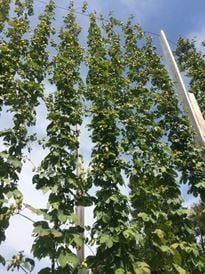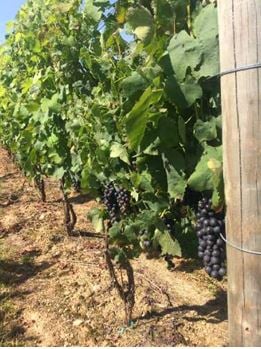

Cheers! It’s Oktoberfest! Let’s drink up some knowledge!
Thanks to Ethan Alpern at the US Geological Society for this fun post.
October 12, 1810 was the royal event of the year, when all citizens of Munich, Germany attended the wedding of Bavarian Crown Prince Ludwig (later to become King Ludwig I) and his bride, Princess Therese of Saxony-Hildburghausen, on the fields in front of the city gates.
The fields were named “Theresienwiese” (“Theresa’s fields”) in honor of the Crown Princess, and for more than 200 years, their anniversary is celebrated with the tradition called Oktoberfest.
Today, Oktoberfest celebrations feature large quantities of pumpkin-spiced beer, but behind that is the fascinating geologic process of making the beer and wine used to celebrate with each year.
Hops: The Geologic Ingredient
 Cascade hops growing tall
Cascade hops growing tall
Hops, the flower of the common hop plant (Humulus lupulus L.), is best known for its use to flavor beers. It is a plant species that grows as a vine and is native to temperate regions of the northern hemisphere, such as North America, Europe, and western Asia.
There are many varieties of hops, which are used in the flavoring process of brewing beer. Each variety, grown in various areas, provides a different accent of flavor, contributing to the different flavors for each brand of beer. Other factors in flavor are ingredients such as barley and wheat, as well as different brewing techniques.
Hops are a species of vine, whose flowers are used in the beer-brewing process. It provides flavor to beer, and has several varieties. This variety is called Cascade.
As hops plays an important role in the flavor of beer, the alcohol and viscosity (thickness) are a function of other ingredients such as the initial sugar content which is then fermented by yeast into alcohol.
The Cascade variety of hops can grow to be extremely large and provide a great harvest and flavor for nearby breweries. Each type of hops requires different soil conditions, but hops in general share some broad requirements.
The soil must be crumbly and well drained with low soil acidity. Hops also require access to a lot of water, so the presence of surface water is extremely beneficial.
Geology Makes a Fine Wine
It’s not just hops that rely on geology, not all grapes are ideal for wine-making. In fact, the soil, geology, and climate combine to make the difference between low-value table grapes and delicious wine. Most winemakers will say that nature and the Earth are as important as people in making the best wine.
 Shiraz grapes on the vine
Shiraz grapes on the vine
Unlike hops, though, cultivators need to be concerned about giving grapes too many nutrients. USGS scientist Larry Meinert describes how grapes, when supplied with too much water and nutrients can over-produce and result in mediocre wine. Unlike most gardening, the more stressed the grapes, the better they become for wine production.
Wine-making grapes, like these Syrah (or Shiraz) grapes, require different growing conditions than grapes meant for eating. Cultivating wine grapes involves trying to concentrate flavors and encourage thicker skins, because these are what give wine much of its color and flavor. To do that, one of the most important factors to look for is the drainage of the soils.
Proper Soil Means the “Sauce” Won’t Spoil
Soil chemistry and nutrients play a big role in the taste of the various hop and grape varieties. Soil drainage is an extremely important factor in the success of grape growing.
The better the drainage, the more concentrated flavor can be in grapes and therefore the better the wine. Better drainage is usually found in loose soils where the water can flow away from the vines. When wine grapes have access to too much water, the sugars are diluted and the grapes grow too large, meaning the skins aren’t thick enough to provide proper flavor and color.
Diatomite: The Natural Filter
Filtering is a key step to the beer and wine-making process. It is important to make sure that these beverages are clean and healthy. Luckily, the Earth has provided a natural filter in the process, a mineral called Diatomite, or diatomaceous earth.
It is used in agriculture for grain storage as an anticaking agent, an insecticide, and as a natural de-wormer.
Diatomite is a chalk-like, soft, and very fine-grained sedimentary rock, usually light in color (white if pure, but usually gray, and rarely black). It is very finely porous, very low in density (floating on water at least until saturated), and essentially chemically inert in most liquids and gases.
The principal use of diatomite is as a filter aid, an absorbent for industrial spills, and in toothpaste. It is also used as filler in a variety of products from paints to dry chemicals, and as insulation material.
Start with Science
Amidst all the fun and festivities, there is still much to learn. USGS provides the science and information to understand the potential, production, and consumption of all minerals, water, and climate conditions in the wine and beer making process.
So whether you’re celebrating Oktoberfest with a cold pumpkin-spiced beer or a glass of red wine, make sure to learn some science with every sip!
EP Minerals produces special Celatom and Celabrew DE grades for wine and beer filtration: Learn More.
For Filtration FAQs, click here.
